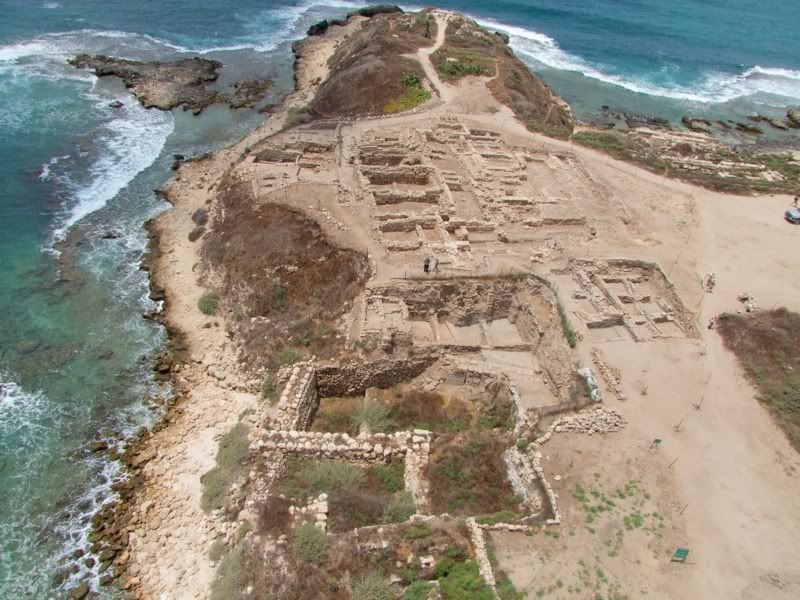Tel Dor by the Sea
About 30 kilometers directly south of Haifa, Israel, lies a very large tel (an earth mound containing ancient architectural and artifact remains) that tells a story crossing at least eight civilizations. The story is largely a commercial one, as the ancient seaport city of Dor on the Mediterranean coast of present day Israel was host to the trading activities of a number of civilizations or cultures that ringed the Mediterranean world in ancient times. Once a Canaanite city, its history spans settlement or rule by "Sea Peoples", Phoenicians, the Solomonic monarchy, Assyrians, Persians, Greeks, and Romans. Finally, in the thirteenth century A.D., a Crusader castle was built on the site. Few sites of the ancient world can boast a settlement history more varied and complex than this.
The 2009 Excavation Season
From July 6 to August 12, the University of Washington (UW) Tel Dor Archaeological Program will resume its field school excavation at Dor under the direction of Professor Sarah Culpepper Stroup. The majority of the participants will be excavating the Hellenistic and late Persian strata under the leadership and instruction of Professor Stroup and associated staff. The area consists of a fascinating complex of industrial buildings. Discoveries from the 2007 season included four large Roman-period tabuns (round local ovens), each of differing construction, several drains and basins, hallways,thresholds, and massive amounts of Roman-period pottery. In the 2008 season, the team excavated through the Roman strata and uncovered the tops of beautifully constructed Hellenistic period walls. Also uncovered were large amounts of fine Hellenistic mold-made ("Megarian") pottery, a few fine pieces of Hellenistic glass, an assortment of bronze tools and weapons, and a somewhat puzzling ashlar installation that instantly gained the affectionate nickname "the crypt". The 2009 season promises to be an exciting one as the expedition returns to more fully explore the Hellenistic strata. Other participants will have the opportunity to excavate in an area with earlier strata -- under the leadership and instruction of Talia Goldman and Yftah Shalev, Israeli graduate students who are also experienced archaeologists and teachers with a long history at Dor. Due to its situation on the south slope of the Tel, this area is stratigraphically rich, with upper levels in the Persian Period and lower levels approaching the Bronze Age. Past discoveries have included -- in the Persian strata -- three dog burials, a street front, a puzzling triple-layer hemicircle of long bones and amphora handles and -- in the Iron Age strata -- a complex of mud-brick rooms and nearly complete vessels filled with lentils and grain. Always an interesting area, its location also boasts the best views of the bay!
The Field School
One of the hallmarks of the Tel Dor Archaeological Program is its rich and intensive course of study, consisting of three major components:
1. Field Work
Students will learn about the past as they unearth it. All students registered in the Field School receive daily instruction and participate each day in the archaeological excavations at Tel Dor. Field excavation is supervised by an experienced team of international archaeologists from Hebrew University in Jerusalem, the University of Haifa, the University of Washington in Seattle, and other institutions, and includes training in excavation techniques, stratigraphy, artifact analysis, and transit elevations.
2. Museum Work
Students will learn what happens to an artifact after it has been excavated. They will receive instruction in various aspects of museology, including cataloguing systems, pottery typology, dating methods, and conservation techniques.
3. Evening Lectures
Students will learn the concepts behind the archaeology. They will attend four evening lectures per week on such diverse topics as the history of Tel Dor, the histories of the civilizations who occupied it, past excavations, day-plans and day-book methods, the ‘digitization’ of modern archaeology, three-dimensional imaging of artifacts, architectural drafting, and a great deal more.
Those who successfully complete the course requirements of the Field School will receive 12 credits (either graded or C/NC) from the University of Washington in either Classics (CLAS) 399, Near Eastern Languages and Civilizations (NELC) 399, or Archaeology (ARCH) 270. These credits can be counted toward a major in these programs.
Join Us
Don't just read about history. Help make a difference -- feel it, discover it, and make it a part of you. You can learn more about the project and the application procedure by going to the website at http://depts.washington.edu/teldor or, alternatively, at http://dor.huji.ac.il.
Contact Information:
Professor Sarah C. Stroup
scstroup@u.washington.edu
Labels: archaeological excavation at tel dor, archaeology in israel, field school in roman archaeology, hellenistic archaeology, tel dor




0 Comments:
Post a Comment
<< Home